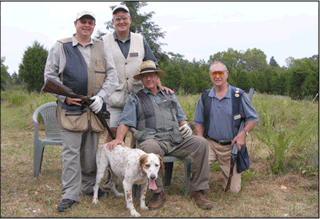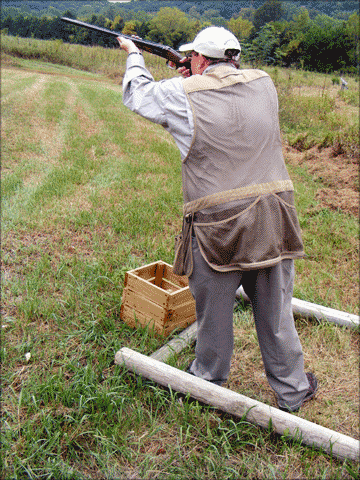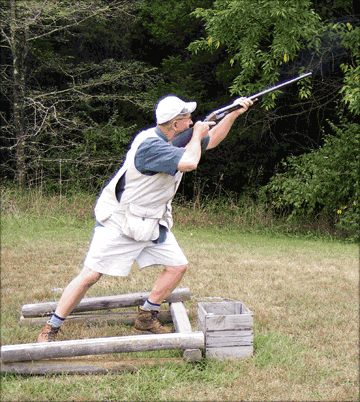A Celebration of Early Season Shooting in the Shenandoah Valley
It was September 9th, eight days after the West Virginia season opener for mourning doves. At the Shenandoah Valley Sportsmen Club, opening-day hunters had maxed out their limit within hours – arriving home in plenty of time for lunch and chores.
But only eight days later, the Shenandoah Valley Sportsmen Club provided us with the tranquility of a relaxed dove hunt. Waiting for the acrobatic birds on our field stools we leisurely picked off the occasional doves as they zoomed into range, our gunfire breaking the prevailing pastoral calm. Personally, a serene shoot at dusk suited me fine.
We shot sporting clays all morning at the nearby Prospect Hall Shooting Club, and after a picnic lunch of cold-cut sandwiches we continued shooting the games of helice and grouse butt.

My shooting companions were Jent Mitchell, president of the Virginia Vintagers chapter, and his friends Darrell McKigney, John Swindle and David Hamilton. John and David only had time for a morning shoot of 100 rounds of sporting clays. Jent, Darrell and I ended up going another 150 rounds each at Prospect Hall before we left for the dove hunt.
We had arrived at the Shenandoah Valley Sportsmen Club in Martinsburg at about 4:30 PM, when the doves would start to fly again. This time, Jent, Darrell and I were joined by Scott Shendon. The job of retrieving birds was given to Jent’s English Setter, Abby II.
As it turned out, Jent and Darrell had hunted there the day before, Darrell reclaiming his place under a nearby shade tree. Scott peeled off further to the right while Jent and I trekked straight ahead, carrying our gear along the tree line deeper into the open field.

When I ultimately plopped down on the field stool, obscured from the doves by a tree and some scrub, I was ready to simply enjoy the remainder of the day. Shooting a few doves would be a bonus. The scenery and weather were ample reward after 250 rounds at the venerable Prospect Hall Shooting Club.
My spot provided an excellent vantage point for doves coming from the northwest and southeast. I was shooting a 12-gauge Fausti Caledon over/under field gun as part of a long-term review. Jent was accompanied by one of his beloved Parkers. Darrell had a vintage AyA and Scott was at the ready with this Beretta 391 semi-auto (my shotgun of choice at Prospect Hall).
The early evening was shirt-sleeves warm and aromatic of autumn. Low storm clouds radiated angled beams of golden sunlight. A sprawling white dairy barn in the distance recalled simpler times and it was easy to slip into a reverie. Waiting for the doves, I found myself lulled into the pleasures of the South.

Earlier that day, the morning still quiet, I had driven some rural back roads lined with stone walls to find myself on a gravel track that gradually revealed the white mansion house of Prospect Hall rising into view.
I got out of my car, the first to arrive, with no one else in sight. The temperature must have been in the 70s and it was a bluebird sky. Meadows and a red barn composed the immediate landscape as the Blue Ridge Mountains lay in the distance. This knoll and the Opequon creek running along the west side of the farm were part of a 639-acre land grant from Lord Fairfax to Joseph Edwards. The original two-room log house stood some 20 feet to the southeast on the 500 acres that still comprised Prospect Hall.
The white brick house, completed in the early 1800s, stood prominent on hallowed ground.
All around here, the farmers of the Shenandoah Valley had fed the Confederacy during the Civil War. Strategically, the region served as a staging area for raids on Pennsylvania, Maryland and Washington.
In 1862, the outnumbered Confederate General Stonewall Jackson defended the Shenandoah Valley against three Union armies. As the Confederacy’s defeat lay imminent, the valley turned to partisan fighting over the loyalties to Confederate John Mosby and his Rangers who frequently operated in the area during a time when the North had adopted a scorched earth policy.
Prospect Hall itself was the location of General Meade’s defeat of the Union Army preceding the Battle of Gettysburg.
Today, Prospect Hall is a private shooting club. The main house is what you’d expect with colonial furniture and cushy leather couches in the sitting room. A well-used commercial kitchen supports the guests and corporate parties, with a conference room for meetings and seminars contiguous to the mansion house.
There was an understated ambiance at Prospect Hall. It bore all the hallmarks of a bed-and-breakfast, but instead of potpourri masquerading as romance the house exuded the masculine vestige of Jent’s old Parkers with their original patina.
Since Darrell was a member of Prospect Hall, he had arranged the day’s events for his guests. As I waited for the others to arrive, an all-wheel-drive “mule” pulled up driven by Phillip Dietrich II, the club’s Hunt and Field Director and an NSCA instructor. He told me to hop in, threw it into gear and gave me a tour of the property.
Most of our conversation centered on his efforts to restore the natural habitat for pheasant, chukar, and Hungarian partridge since his arrival here five years ago. Prospect Hall specializes in upland style bird hunts September 1 through April 30. The biggest challenge for him was clearing the cedar trees allowed to mature, and then disposing of them. While many of the cedars still lined the wild meadows and harvested plots of milo, millet, corn, and sorghum, you could see a few piles of cedar debris awaiting removal. In the mean time, Phil was happy to have the tangled mounds serve as home to rabbits.
He also explained that on the other side of the property Prospect Hall hosts European Style Shooting for ducks and pheasants. Hunters are assigned “pegs” on stands along the creek. Birds are released from the cliff overlooking the creek, creating the high-shot experience of a driven shoot.
Another release bird shoot at Prospect Hall places hunters in blinds that circle a hill. Game birds are released from the hill top and the hunters rotate through the blinds in the fashion of a tower shoot.
By the time Phil and I returned to the parking lot some of my shooting companions had arrived. Jent had previously mentioned that I brought along two Faustis for them to shoot for our Peer Review columns: a 20-gauge Fausti Dea Round Body side-by-side with double triggers and the over/under Caledon that I would end up using on doves at the Shenandoah Valley Sportsmen Club.
Everyone was eager to see the Faustis and so I brought them into the dining room and laid them out on the ample, antique table. A lively conversation ensued over fresh-brewed coffee as they closely examined the guns, with the Dea Round Body drawing praise for its appearance and finish.
With coffee done and the sun moving high it was time to shoot sporting clays on Prospect Hall’s 24-station course. Jent loaded up a tricycle cart with two 12-gauge Parkers, while Darrell brought his AyA. David also brought a 12-gauge Parker and John had a Winchester Model 21. I had brought along my “blasphemous” Berretta 391 semi-auto, as well as both Faustis in the event anyone wanted to give them a try.
Our trapper, Jimmy, drove the mule and we were to walk the undulating course with Abby II taking our lead.
Shooting sporting clays at Prospect Hall is perhaps the closest you can get to upland hunting. All the traps are well obscured in the tall grasses. Instead of cages, three logs framed the station. The presentations were mostly moderate crossers and outgoers. There were fast, quartering-away rabbit pairs that quickly showed you only their trailing edge, and a long, quartering crosser skimming the tall grass. But an intermediate shooter could have scored well in the first half of the course.

Darrell had opted for the Fausti Dea Round Body at about the fifth station. He quickly took to the gun and made some phenomenal shots with it for the remainder of the course.
About two-thirds through the course we came to the 50-foot tower. Jimmy scaled the ladder, throwing quartering birds over the tree tops. After several rounds, we descended a set of overgrown steps into a staging area that turned the tower shots into a high, incoming flurry. Several of the guys started shooting backup to their companions and Darrell described how they would often spend hours here with a picnic lunch delighting in the high incomers.
Our ammo bags had been left at the base of the tower and when we ran out of shells it was time for lunch. John left but David joined us at the picnic table on the front lawn of the mansion house.
Jent had the turkey and roast beef sliced particularly thick, making the sandwiches especially savory and delicious after walking the entire sporting clays course. We then took our cars to the helice course.

For those of you unfamiliar with helice, the game replicates live pigeon shoots. The helice targets are distinguished by their propellers and the hub holds a white plastic cap called a witness. With the trapper at the control panel behind the shooter, the shooter calls pull and one of the boxes in the fenced ring is selected at random to launch an oscillating bird (there are five to seven traps in a ring). You score only if you’re able to dislodge the witness and have it land within the ring (again, like pigeon shoots). Merely hitting the propeller does not constitute a point.
After Darrell and I shot two rounds of helice, we went across the road to the grouse butt course. Grouse butt consists of an oscillating trap machine with four stations, each at a point of the compass. The Prospect Hall course included a fifth station in which you step down into a concrete blind as the birds fly overhead. We shot 100 rounds of grouse butt and by now I was pretty exhausted.
We were running late for the dove hunt, though, and quickly packed up. We drove some 12 miles west where Scott was waiting for us. After registering in the sparse clubhouse, we jumped into two SUVs and navigated across several fields to our assigned areas.
Before long, the four of us were stationed in the field waiting for the doves. Eyes skyward, the storm front backlit by the late afternoon sun kindled that inner warmth you feel with approaching autumn. Even though my eyes looked up, my heart was elsewhere. I missed a few easy doves that crossed my path and made a couple of difficult shots purely out of instinct with the aid of the fast-moving Fausti Caledon. Then I would slowly take my place in the field stool to wait again, wishing I had brought some cigars to enjoy the sunset.
Irwin Greenstein is Publisher of Shotgun Life. Please send your comments to letters@shotgunlife.com.
Useful resources:
{loadposition signup}

Irwin Greenstein is Publisher of Shotgun Life. Please send your comments to letters@shotgunlife.com.


Comments